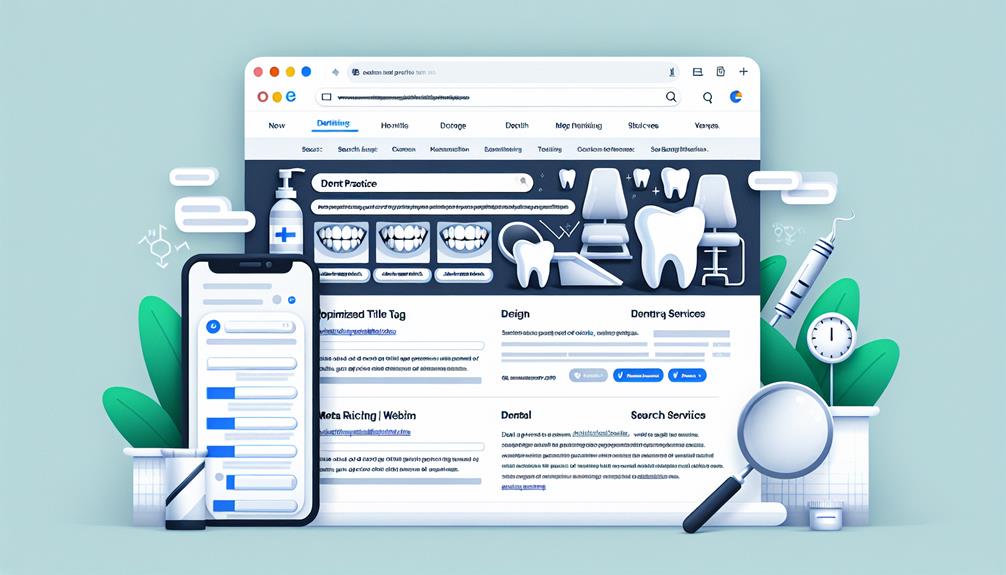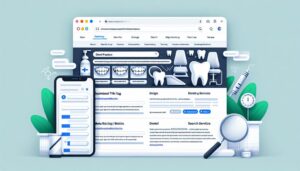When it comes to managing a dental website, you might think that Search Engine Optimization (SEO) can be a complex and time-consuming task. However, fear not, as there are simple and effective on-page SEO tips tailored specifically for dental websites that can help boost your online presence and attract more potential patients.
By implementing these strategies, you can enhance your website’s visibility in search engine results and stay ahead of the competition.
But how exactly can you optimize your dental website to reach its full potential and attract more visitors?
Key Takeaways
- Conduct thorough keyword research and incorporate location-specific keywords for local targeting.
- Optimize website speed by minimizing HTTP requests, optimizing image sizes, and implementing responsive design for improved user experience.
- Focus on mobile-friendly design and user experience through responsive layouts, optimized images, and simplified navigation menus.
- Utilize relevant keywords, engaging multimedia content, and structured formats to optimize on-page SEO for dental websites.
Keyword Research
Perform thorough keyword research to identify the most relevant and high-performing terms for optimizing your dental website’s on-page SEO. Start by conducting a competitive analysis to understand what keywords your competitors are targeting successfully. This insight can guide you in selecting keywords that will give you an edge in the market.
In addition to competitive analysis, focus on local targeting to attract patients in your area. Incorporating location-specific keywords can help your dental practice rank higher in local search results, making it easier for potential patients to find you when searching for dental services in your area.
Optimize Meta Tags
When optimizing meta tags for your dental website, focus on perfecting your title tags by including relevant keywords and keeping them concise.
Ensure that your description tags provide a clear and compelling summary of each webpage’s content, enticing users to click through to your site.
Title Tag Optimization
To enhance the visibility and click-through rates of your dental website, focus on fine-tuning your title tags with strategic keywords and compelling descriptions. Start by incorporating essential SEO strategies into your title tags.
Conduct thorough competitor analysis to identify keywords that can give you an edge. Ensure your title tags are concise yet descriptive, accurately reflecting the content on each page. Utilize keywords that potential patients are likely to search for when looking for dental services.
Crafting attention-grabbing titles can significantly impact your website’s search engine rankings and user engagement. Remember, optimizing your title tags is a crucial step in improving your dental website’s overall SEO performance and attracting more visitors.
Description Tag Best Practices
Implementing strategic and engaging description tags on your dental website can substantially boost user engagement and improve search engine visibility. To make the most of your description tags, follow these tips:
- Character Limit: Keep your description under 160 characters to ensure it displays fully in search results.
- Importance of Keywords: Include relevant keywords naturally within the description to signal search engines about your content.
- Engagement Factor: Craft compelling descriptions that entice users to click by highlighting unique services or promotions.
Improve Website Loading Speed
To enhance your dental website’s loading speed, optimize image sizes by compressing them without compromising quality.
Minimize HTTP requests by simplifying your site’s design and reducing elements that require separate server calls.
Enable browser caching to store frequently accessed data on visitors’ devices, improving load times for returning users.
Optimize Image Sizes
Consider resizing and compressing images on your dental website to enhance loading speed and improve user experience. Image optimization plays a crucial role in boosting your site’s performance.
Here’s how you can achieve this:
- Image Compression: Reducing image file sizes without compromising quality can significantly speed up your website.
- Image Alt Text: Including descriptive alt text not only improves accessibility for visually impaired users but also enhances SEO by providing search engines with more context about your images.
- Responsive Images: Implementing responsive design techniques ensures that images are displayed appropriately on various devices, further enhancing user experience and site speed.
Minimize HTTP Requests
How can reducing the number of HTTP requests on your dental website significantly enhance its loading speed and overall performance? By minimizing HTTP requests, you can improve your site’s speed and user experience. Each time a browser makes an HTTP request for a file from your server, it adds to the loading time. One effective way to reduce these requests is by consolidating resources such as CSS files, JavaScript, and images. This process helps decrease the number of times a browser needs to communicate with the server, ultimately speeding up your website. Moreover, optimizing server response times can further enhance loading speed, ensuring that visitors have a seamless browsing experience on your dental website.
| Resource Type | Number of Requests |
| CSS Files | 2 |
| JavaScript Files | 3 |
| Images | 5 |
Enable Browser Caching
By implementing browser caching on your dental website, you can further optimize loading speed and enhance user experience, building on the efficiency gained from minimizing HTTP requests.
To maximize the benefits of browser caching, consider the following:
- Cache Management: Utilize tools like WP Rocket or W3 Total Cache to effectively manage and control your website’s caching settings, ensuring optimal performance.
- Browser Compatibility: Ensure that your caching settings are compatible with a wide range of browsers to guarantee a seamless experience for all visitors.
- Regular Updates: Stay informed about the latest advancements in caching technology and regularly update your caching mechanisms to stay ahead of the curve and maintain a fast-loading website.
Create Quality Content
Craft engaging blog posts and informative articles that address common dental concerns and provide practical solutions for your audience. When creating content for your dental website, focus on topics that resonate with your patients. Write about the latest dental treatments, oral hygiene tips, or even fun facts about oral health. By offering valuable information, you not only engage your audience but also position yourself as an authoritative source in the dental field.
Incorporate relevant keywords naturally into your content to improve its search engine visibility. Use terms that your target audience is likely to search for when looking for dental information online. Additionally, make sure your content is shareable on social media platforms. Encourage social media sharing by including social sharing buttons on your blog posts and articles. This can help increase your content’s reach and attract more visitors to your website.
Utilize Internal Linking
Utilizing internal linking on your dental website enhances user experience, boosts SEO rankings, and strengthens the overall structure of your site. When done strategically, internal linking can significantly benefit your website.
Here’s how you can make the most out of internal linking on your dental website:
- Anchor Text Strategy: By using relevant anchor text for your internal links, you provide visitors with clear expectations of where the link will take them. This not only enhances user experience but also helps search engines understand the context of the linked pages.
- SEO Benefits: Internal linking plays a crucial role in distributing link juice throughout your website. This helps search engines discover and index new pages more efficiently, ultimately boosting your SEO efforts.
- Improved User Experience: When you interlink related content within your website, you make it easier for visitors to navigate and find valuable information. This seamless navigation enhances user experience, encouraging visitors to spend more time on your site and explore further.
Mobile-Friendly Design
Strengthening your dental website through strategic internal linking sets the foundation for a seamless user experience, now turning our focus to optimizing for mobile-friendly design. When it comes to mobile-friendliness, ensuring your website has a responsive layout is crucial for providing a smooth user experience across different devices. A responsive design adapts to various screen sizes, making it easier for visitors to navigate your site on smartphones or tablets.
Consider the following aspects to enhance your dental website’s mobile-friendliness:
| Mobile-Friendly Design Tips | Benefits |
| Implement a responsive layout | Ensures optimal user experience on all devices |
| Use legible font sizes | Enhances readability on smaller screens |
| Optimize images for quick loading | Improves site speed and user engagement |
| Simplify navigation menus | Facilitates easy browsing on mobile devices |
| Test usability across devices | Ensures consistent performance for all visitors |
Frequently Asked Questions
How Can I Improve the User Experience on My Dental Website?
To enhance user experience on your dental website, focus on improving navigation for easy browsing. Incorporate visually appealing elements to engage visitors. Streamline information flow and optimize layout for quick access to important details.
What Are Some Effective Ways to Encourage Patient Reviews and Testimonials on My Website?
To boost your online reputation and patient engagement, encourage reviews and testimonials on your site. Happy patients spread the word. Make it easy for them by offering incentives, showcasing positive feedback, and providing a user-friendly review process.
How Can I Optimize My Website for Local Search and Attract More Local Patients?
To optimize your website for local search and attract more local patients, focus on local advertising and online promotions. Use targeted keywords, create location-specific content, and ensure your site is mobile-friendly for an enhanced user experience and improved search rankings.
What Are Some Common Mistakes to Avoid When Optimizing a Dental Website for Search Engines?
You’d think avoiding keyword research and content optimization is smart when optimizing a dental site. Wrong move! Skip these, and watch your site struggle to attract local patients. Embrace these strategies for success!
How Can I Track and Measure the Success of My On-Page SEO Efforts for My Dental Website?
Track and measure your on-page SEO efforts for your dental website by utilizing SEO analytics tools. Monitor key metrics like traffic, keyword rankings, and conversion rates. Optimize based on data insights to improve performance and visibility.
Conclusion
In conclusion, optimizing your dental website for on-page SEO is crucial for attracting more patients and growing your practice.
Did you know that websites ranking on the first page of Google receive 91.5% of all organic traffic?
By implementing these quick tips such as keyword research, meta tag optimization, and internal linking, you can improve your website’s visibility and ultimately drive more traffic to your practice.
Keep up with the latest SEO trends to stay ahead of the competition and continue to attract new patients.

Suraj Rana is a renowned Dental SEO Expert, deeply committed to elevating dental practices in the online landscape. With a profound understanding of technical SEO, he specializes in tailoring on-page optimization strategies specifically for the dental industry. Suraj’s extensive experience spans across various sectors, but his passion truly lies in transforming the digital presence of dental clinics. His expertise in dental-specific search engine optimization, combined with a data-driven approach, empowers him to develop strategies that significantly increase organic traffic, enhance search engine rankings for dental-related keywords, and ultimately drive business growth for his dental clients. Suraj Rana’s unique blend of SEO skills and dedication to the dental field make him an invaluable asset to any dental practice looking to thrive online.


